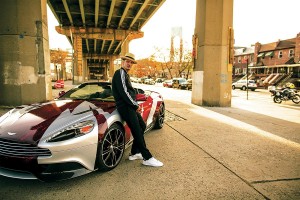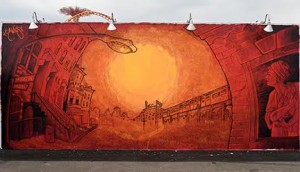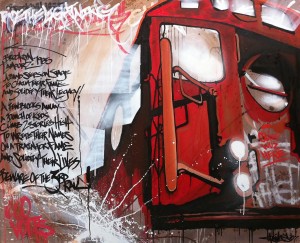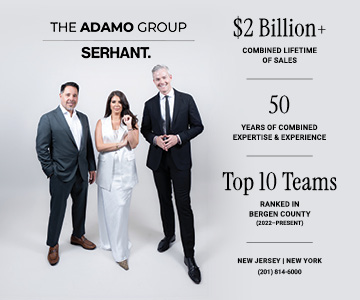Michael Mcleer, also known as Kaves, is an artist. It would be easy to call him a graffiti artist but that is linguistically a narrow definition for what Kaves does, because yes he spraypaints, but he also paints, tattoos, performs hip hop (as a member of Lordz of Brooklyn) and even acts and directs. But Kaves, in his own mind would be comfortable with the label “graffiti artist” because everything he does whether it involves a spray can or not encompasses graffiti. For Kaves, graffiti is a state of mind that is not bound by a single medium, but represents a devotion to self expression, to folklore and making a mark on the world.
How did you define success coming up as a young graffiti artist? Did you ever envision any kind of future in the art world?
How I define success is doing something you love. So I guess since I was a little kid, as far back as I can remember, I was always content with a pad and a pen in some corner, some room, drawing whatever came to my imagination. I always felt like it was my thing, something I can actually get lost in and something you’re born with, so it just came really naturally to me. I came from very humble beginnings so it has definitely shaped who I was and how I could kind of break out of my shell and get attention by drawing and creating. And it just so happens I lived on a block where graffiti was on fire in the early 80’s in New York City. A group of kids
who lived on the same block, saw me drawing in the street with chalk and knew I had talent so I got knighted into a graffiti crew and got my name Kaves, handed down to me from an older graffiti writer so I found a calling, but in my neighborhood there weren’t a lot of creative outlets. Of course there were sports, and either you were a cop or a gangster in my part of Brooklyn but there weren’t a lot of creative outlets for art, so graffiti was something that, you know, you can grab a can of spray paint and make a mark, maybe on the world.
How old were you when you first started tagging?
Ten years old. We were 10, 11, 12 year olds running around the city like Tom Sawyer. It’s crazy to see that, to imagine that cause my kids themselves, I wouldn’t let them off the block, so it’s amazing that that’s what it was. Our communication and networking, our social media, social networking, and Internet were the subway lines, and subway tunnels. The subway tunnels became our summer camp.
At this time were you also doing stuff on canvas?
No, the canvas came out of necessity after. I made a name for myself on the street. Writing on the trains was definitely illegal but we thought we were beautifying. If you grew up in the 70’s and 80’s, New York was definitely a dirtier place, dirtier time, because the city was broke so we were trying to do something, trying to communicate with each other, trying to brighten up drab surroundings. So I came from that and the canvas and that type of thing came later on, as graffiti started becoming more accepted there started to be a demand for that, but I kept it pretty outlaw for the first part of my career.
When did you start getting recognition for your work in a conventional sense? When were you first commissioned to do an art piece?
Well, I had a little frump with the law on the subway cars and so I started promoting and painting backdrops at a local nightclub in my neighborhood. I brought early rap groups there such as Public Enemy, KRS-One, Big Daddy Kane, and I would do the background of the stages and the signs. With the notoriety I had in the neighborhood, in ‘85 I think, the first big mural that we did was for a book called Spraycan Art by Henry Chalfant. Henry just finished a book Subway Art which is the bible of graffiti in New York City subways. That put me and a lot of other graffiti artists on the map where people started commissioning work. I started doing it but I wasn’t someone who jumped head first into it. I felt like I had another medium to tell my story and we started a rap band called the Lordz of Brooklyn. We made a name for ourselves with that as well but I always felt like it didn’t matter what medium it was, that graffiti was a state of mind, it was a way to make a mark on whatever you were doing. Eventually I was asked to start painting canvases or whatever commission pieces for people.
 What attracted you to tattooing?
What attracted you to tattooing?
Like these outlaw arts, tattooing was another one that was considered underground art, but in our neighborhood very noble. When you were coming of age as a young man, your tattoo was something that was sacred and embodied you and was another form of reinventing yourself, a creative outlet to make something personalized, so I always dug that about a tattoo artist. It was a profession where you can actually get paid to do your art and there’s no bullshit in between. You did your art, you did your service and you got paid for it and it was nice to see people walk around with your artwork on them. So instead of the train, displaying your artwork on people’s bodies and that really appealed to me and I picked up a tattoo machine and made a career out of tattooing the last 16 years. I felt it was just another form of graffiti. You can call it street art, you can call it graffiti art, but it’s really raw folk art. I like to believe that it’s folk art and I’m a folklorist.
I like that. You talk about using graffiti and rap to tell your story, but tattooing is a way of telling other people’s stories.
Exactly. It’s been something hands on that I’ve created on my own. Me and my peers, we kind of made this from nothing, from the streets, so we’re very proud of it and pioneered a lot of this stuff. And now it’s nice to see that you can actually make a career and a living and not just that it’s become so popular and appreciated as an artform, so it’s great to see it come full circle. It’s nice to see that this eventually turned out to be something you can be very proud of, make your mom proud. It’s amazing to me that my paintings would hang in the Rock and Roll Hall of Fame or Gunter Sach’s private collection in Germany. It’s a dream come true that you can do something that you love and people probably frowned upon when we were younger but now turned into something legitimate.
It’s amazing how times have changed.
And now you see these big brands and other kinds of craftsmen tipping their hat at this craft as well. Like recently, I painted an Aston Martin which was pretty prestigious, that a company like Aston Martin would come to an artist from Brooklyn and ask him to collaborate on something that amazing.
Did that make you nervous?
I’ve painted train cars which made you way more nervous that the cops were after you, but it’s prestigious and it’s a mark of a hundred years of craftsmanship, to put that in my hands and appreciate my own craftsmanship. And they wanted to make a bold statement which was very risky of them and when you see the car, don’t be fooled, it’s not a car for the average driver to go drive on the weekends, this is an art piece that belongs in a museum or gallery as a statement that artists make.
What was your creative process when painting the car? Was it improvisational?
Very much so because looks are deceiving, that car has not a flat surface on it, it’s very curvy, it’s an incredible work of art. They approached me because they liked the fact that I’m a multi-ranged artist and they were looking for something tattoo inspired. So they wanted to treat the car as if it was someone getting tattooed. Like someone that walks into my shop, you never know the surface because everyone’s body is different, so you have to wrestle with the skin texture, same with the car. You can’t approach it, put a paint brush to it and get a straight line, so I had to go back to the days of my youth painting trains and take out the spray cans and go at it with that kind of excitement and improv.
What’s your involvement now with the graffiti community?
I’m still doing it. It’s still growing and myself, as an artist, I like to push myself as far as I can take it. Maybe some of the painting might become more refined or I might lose or gain a technique but I like to think I got that same fire burning in me as a child about telling these stories and using these tools that are in front of me. Right now I could be doing some lettering on a tattoo but then switch to something more fine on canvas and always have the graffiti spirit and that soul of the child that wanted to make a name for himself.







